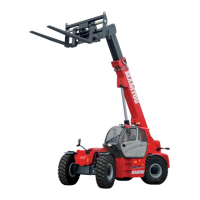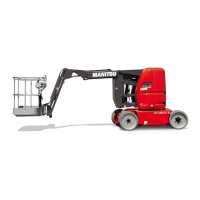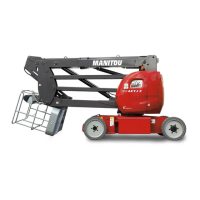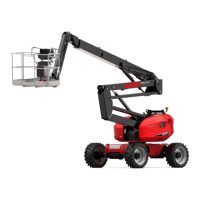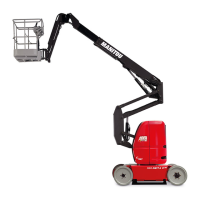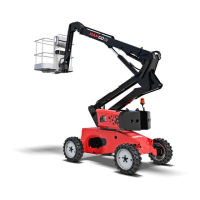
Do you have a question about the Manitou MAN'GO 12 and is the answer not in the manual?
| Brand | Manitou |
|---|---|
| Model | MAN'GO 12 |
| Category | Boom Lifts |
| Language | English |
Introduction, site requirements, operator qualifications, and platform suitability.
Proper handling, replacement of manuals, and requirements for qualified maintenance personnel.
Operator risks, manual usage, authorization, maintenance, and modification rules.
Details on platform axle types and procedures for driving the equipment.
Site regulations, load, passageways, and wind evaluation scale for safe operation.
Maintaining visibility during operation and steps for starting the engine.
Safe driving practices and procedures for stopping the platform.
Safety measures for electric welding and blow torch use on the platform.
Preparation, log, lubricant levels, and battery electrolyte checks.
Warnings for hydraulic components and electrical safety.
Preventing damage during storage and protecting the engine.
Battery charging and platform protection during storage.
Guidelines for material recycling and environmental protection.
Arrows for translation direction and wheel load information.
Procedures for towing, safety advice, and load capacity.
Attachment points for lifting and location of platform keys.
Warnings to stay clear of operating area and risk of burns.
Warnings about risks of being crushed by moving parts.
Origin indication, anti-freeze, and washing recommendations.
Where to attach safety harnesses.
Platform stability chart and sensor/coil fault code information.
Information on the manufacturer's plate, including type, serial no., and year.
Location and identification of IC Engine and Hydrostatic Pump.
Capacities, dimensions, and weight details for the platform.
Timings for arm, turret, and basket movements.
Engine type, fuel, capacity, power, and torque details.
Details on transmission type, pressure, and wheel configuration.
Brake type, control, and torque information.
Pump types, capacities, pressures, and filtration details.
Battery, starter, and alternator details.
Width, length, height, and clearance measurements in transport mode.
Working height, offset, and tail swing measurements.
External dimensions and floor area of the basket.
Reservoir capacities for hydraulic oil, diesel, engine oil, and coolant.
Information on emergency pump, hour meter, and optional features.
Detailed measurements (A-K) of the platform in transport configuration.
Visual representation of dimensions in work mode.
Chart of overhang, offset, and height for building access.
Overview of platform structure, controls, and intended use.
Procedures for using the machine, including driving and parking.
Indicators and actions for platform tilt and overload conditions.
Identification of controls on the base console.
Detailed explanation of each control on the base panel.
Identification of controls and indicators on the basket console.
Detailed explanation of each control on the basket console.
Operation of key switch, starter, and ground/basket control selection.
Function of emergency stop button and its proper usage.
Operation of the dead man's pedal and basket tilt controls.
Procedures for rotating the turret and moving the lower arm.
Operation of pendular arm lift/lower and telescope extend/retract.
Blocking turret rotation and function of the flashing light.
Function of tilt sensor, safety buzzer, and their indicators.
Operation of lever for arm movement and joystick for platform translation.
Function of emergency stop and reference to chassis arrows for direction.
Operation of preheating light and start-up control.
Function of differential lock and buzzer control buttons.
Low fuel warning and translation speed selection.
Warning lights for overload and tilt conditions.
Button to utilize prohibition on movements when tilting.
Function of the dead man's pedal and buzzer activation.
Use of harness points and safety rail for climbing.
How the SafeManSystem disables controls when activated.
Precautions and use of the generator option.
Information on genuine parts, filters, cartridges, belts, and lubricants.
Summary of maintenance tasks based on operating intervals.
Tasks for daily, 50, 250, 500, 1000, and 2000 hour checks.
Maintenance tasks performed on an as-needed basis.
Importance of using genuine parts and risks of non-genuine parts.
Part numbers and replacement intervals for engine filters and alternator belt.
Part numbers and cleaning intervals for hydraulic filters and strainers.
Part numbers for sensors and dead man's pedal.
Recommended oils, capacities, and fuel specifications.
Recommended grease for the front direction pivot.
Lubrication for general points and turret crown gear.
Recommended hydraulic oil for the reservoir.
Schedule for engine checks, adjustments, and replacements.
Schedule for transmission and tyre checks and replacements.
Schedule for lifting structure and hydraulic system checks.
Schedule for electrical, chassis, and platform inspections.
Schedule for maintenance of optional systems like SafeManSystem.
Scrupulous inspection for damage, leaks, and loose connections.
Testing emergency stop, dead man's function, buzzer, and movements.
Testing tilt and overload sensors for proper function.
Procedures for checking engine oil, coolant, and fuel levels.
Checking hydraulic oil level and condition of joystick bellows.
Inspecting tyres and checking Safe Man System status.
Checking and maintaining battery electrolyte levels safely.
Inspecting fuel hoses for damage to prevent fire hazards.
Cleaning and greasing direction pivots for smooth operation.
Checking and adjusting belt tension for proper operation.
Cleaning the radiator core to prevent clogging.
Cleaning the dry air filter cartridge using compressed air.
Step-by-step instructions for replacing the fuel filter cartridge.
Checking and tightening wheel nuts to specified torque.
Verifying the correct operation of the emergency pump.
Checking and adjusting the tightness of telescope arm skids.
Checking the oil level in the turret's reduction gear brake.
Lubricating bearing raceways and teeth of the turret crown.
Cleaning and greasing points on axles, hubs, and joints.
Tightening hydraulic engine bolts and checking arm position sensors.
Testing tilt and overload sensors for proper function.
Inspecting coolant hoses for damage or leaks.
Cleaning fuel filter and checking/adjusting belt tension.
Ensuring safety stickers are present and checking overload activation.
Testing stopping distances on horizontal ground and brake holding on slopes.
Replacing dry air filter and safety cartridges.
Replacing fuel filter and pre-filter cartridges.
Replacing the hydrostatic transmission oil filter cartridge.
Replacing the auxiliary hydraulic oil filter cartridge.
Procedures for draining, cleaning strainers, and refilling hydraulic oil.
Inspecting hydraulic hoses for cracking, wear, and leaks.
Checking tightness of turret motor and crown gear bolts.
Testing the braking system by disconnecting the coil.
Replacing the alternator, fan, and crankshaft belt.
Procedures for replacing the engine oil filter and refilling oil.
Checking battery electrolyte density for charge status.
Draining and refilling oil for the turret motor reducer brake.
Inspecting cylinders for leaks, rod impacts, and valve blocks.
Procedures for draining and cleaning the fuel tank.
Replacing safety air filter cartridge and checking cable bundles.
Cleaning hydraulic rack and checking engine silentblocks and speeds.
Checking hydrostatic transmission pressures, control, and movement speeds.
Checking and adjusting the set of valves.
Procedures for draining and refilling the engine coolant.
Checks for water pump, thermostat, alternator, starter, and hydraulic reservoir.
Checks for hydraulic circuits, outputs, and fuel injection pressure.
Checks for injection pump and radiator descaling.
Bleeding fuel system and procedure for changing wheels.
Procedure for loading and securing the platform on a truck bed.
Steps to activate freewheeling mode for towing the platform.
Procedures and points for hoisting the platform using slings.
